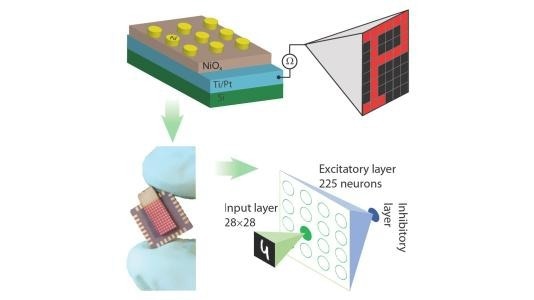The Advanced Photon Source was utilized by the researchers to watch a nonliving material mimic behavior linked to learning. This sets the stage for better artificial intelligence.
 Researchers have designed a nickel oxide-based system that demonstrates learning behaviors and is easily implementable in RRAM arrays. Image Credit: Purdue University/Sandip Mondal.
Researchers have designed a nickel oxide-based system that demonstrates learning behaviors and is easily implementable in RRAM arrays. Image Credit: Purdue University/Sandip Mondal.
Researchers looking to make a new generation of supercomputers desire to have inspired by the most complicated and energy-efficient computer ever built: the so-called human brain.
In a few of their initial forays into creating brain-inspired computers, scientists are looking at various nonbiological materials whose properties could be customized to show proof of learning-like behaviors.
Such materials could develop the foundation for hardware that can be matched with new software algorithms to allow highly potent, beneficial, and energy-efficient artificial intelligence (AI).
In a new study headed by researchers from Purdue University, scientists have uncovered oxygen-deficient nickel oxide to brief electrical pulses and evoked two different electrical responses that seem to be similar to learning.
The outcome is an all-electrically driven system that displays these learning behaviors, stated Rutgers University Professor Shriram Ramanathan. (Ramanathan was a professor at Purdue University at the time of this work.)
The research group used the Advanced Photon Source (APS) resources, a US Department of Energy (DOE) Office of Science user facility at DOE’s Argonne National Laboratory.
The initial response, habituation, happens when the material “gets used to” being zapped. The researchers observed that even though the material’s resistance rises following an initial jolt, it soon turns out to be usual to the electric stimulus.
Habituation is like what happens when you live near an airport. The day you move in, you think ‘what a racket,’ but eventually you hardly notice anymore.
Fanny Rodolakis, Physicist and Beamline Scientist, Advanced Photon Source, Argonne National Laboratory
The other response displayed by the material, sensitization, happens when a bigger dose of electricity has been administered.
With a larger stimulus, the material’s response grows instead of diminishing over time. It’s akin to watching a scary movie, and then having someone say ‘boo!’ from behind a corner—you see it really jump.
Fanny Rodolakis, Physicist and Beamline Scientist, Advanced Photon Source, Argonne National Laboratory
Ramanathan stated, “Pretty much all living organisms demonstrate these two characteristics. They really are a foundational aspect of intelligence.”
These two behaviors have been regulated by quantum interactions between electrons that classical physics cannot explain and that assist to develop the foundation for a material’s phase transition.
An example of a phase transition is a liquid becoming a solid. The material we’re looking at is right on the border, and the competing interactions that are going on at the electronic level can easily be tipped one way or another by small stimuli.
Fanny Rodolakis, Physicist and Beamline Scientist, Advanced Photon Source, Argonne National Laboratory
Ramanathan stated that the availability of a system that could be entirely regulated by electrical signals is necessary for brain-inspired computing applications.
Rodolakis explained, “Being able to manipulate materials in this fashion will allow hardware to take on some of the responsibility for intelligence. Using quantum properties to get intelligence into hardware represents a key step towards energy-efficient computing.”
The variation between sensitization and habituation can help researchers conquer a difficulty in developing AI, known as the stability-plasticity dilemma. On the other hand, artificial intelligence algorithms could usually be too unwilling to adapt to new data.
However, at the same time, when they do, they can frequently overlook a few of what they have learned earlier. By making a material that has the potential to habituate, researchers can teach it to overlook or forget unnecessary data and thus reach extra stability. At the same time, sensitization can train it to remember and integrate new information, facilitating plasticity.
Rodolakis stated, “AI often has a hard time learning and storing new information without overwriting information that has already been stored. Too much stability prevents AI from learning, but too much plasticity can lead to catastrophic forgetting.”
One major benefit of the new study included the small size of the nickel oxide device.
Rodolakis added, “This type of learning had previously not been done in the current generation of electronics without a large number of transistors. This single junction system is the smallest system to date to show these properties, which has big implications for the possible development of neuromorphic circuitry.”
To discover the atomic-scale dynamics liable for the habituation and sensitization behaviors, Rodolakis and Argonne’s Hua Zhou utilized X-Ray absorption spectroscopy at beamlines 29-ID-D and 33-ID-D of the APS.
The study was financially supported by DOE’s Office of Science (Office of Basic Energy Sciences), the Army Research Office, the Air Force Office of Scientific Research, and the National Science Foundation.
Journal Reference:
Mondal, S., et al. (2022) All-Electric Nonassociative Learning in Nickel Oxide. Advanced Intelligent Systems. doi.org/10.1002/aisy.202200069.
Source: https://www.anl.gov/